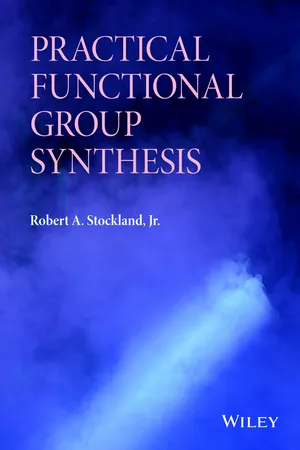
- English
- ePUB (mobile friendly)
- Available on iOS & Android
Practical Functional Group Synthesis
About This Book
A practical handbook for chemists performing bond forming reactions, this book features useful information on the synthesis of common functional groups in organic chemistry.
•Details modern functional group synthesis through carbon-heteroelement (N, O, P, S, B, halogen) bond forming reactions with a focus on operational simplicity and sustainability.
•Summarizes key and recent developments – which are otherwise scattered across journal literature – into a single source
•Contains over 100 detailed preparations of common functional groups
•Included 25 troubleshooting guides with suggestions and potential solutions to common problems.
•Complements the text in enhanced ebook editions with tutorial videos where the author provides an introduction to microwave assisted chemistry
Frequently asked questions
Information
1
INTRODUCTION TO PRACTICAL FUNCTIONAL GROUP SYNTHESIS
1.1 GENERAL APPROACHES FOR DESIGNING SYNTHESES
- What is the goal of the synthesis?
- How pure do the intermediates and products need to be?
- Are all of the reagents/catalysts/additives commercially available?
- If the starting materials are not commercially available, how long will it take to make them?
- Are there any reaction specific issues that need to be considered?
- How long will it take to complete the proposed synthesis?
- Is the shortest route really the most practical?
- Will the chemistry benefit from microwave irradiation?
- Is a glovebox required?
- Does the chemistry require the use of a vacuum/inert gas manifold?
- What are the safety concerns for this approach?
- Are the reagents/catalysts sensitive to light?
- Is a solvent needed?
- Do the solvents need to be rigorously dried?
- Will the solvents be easy to remove?
- Do the solvents need to be degassed/deoxygenated?
- Are the products stable to air?
- How will the products be purified?
- How will the products be stored?
- How will the products be characterized?
What is the goal of the synthesis?
How pure do the intermediates and products need to be?
Are all of the reagents/catalysts/additives commercially available?
If the materials are not commercially available, how long will it take to make the starting materials?
Are there any reaction specific issues that need to be considered?
How long will it take to complete the proposed synthesis?
Is the shortest route really the most practical?
Will the chemistry benefit from microwave irradiation?
Table of contents
- COVER
- TITLE PAGE
- TABLE OF CONTENTS
- PREFACE
- ACKNOWLEDGMENTS
- 1 INTRODUCTION TO PRACTICAL FUNCTIONAL GROUP SYNTHESIS
- 2 PREPARATION OF ALCOHOLS, ETHERS, AND RELATED COMPOUNDS
- 3 SYNTHESIS OF AMINES, AMIDES, AND RELATED COMPOUNDS
- 4 SYNTHESIS OF ORGANOPHOSPHINES, PHOSPHONATES, AND RELATED COMPOUNDS
- 5 SYNTHESIS OF THIOETHERS, SULFONES, AND RELATED COMPOUNDS
- 6 SYNTHESIS OF ORGANOBORONIC ACIDS, ORGANOBORONATES, AND RELATED COMPOUNDS
- 7 SYNTHESIS OF ORGANOHALIDES
- INDEX
- END USER LICENSE AGREEMENT